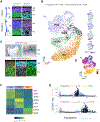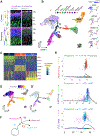Single-Cell Transcriptomic Comparison of Human Fetal Retina, hPSC-Derived Retinal Organoids, and Long-Term Retinal Cultures
- PMID: 32023475
- PMCID: PMC7901645
- DOI: 10.1016/j.celrep.2020.01.007
Single-Cell Transcriptomic Comparison of Human Fetal Retina, hPSC-Derived Retinal Organoids, and Long-Term Retinal Cultures
Abstract
To study the development of the human retina, we use single-cell RNA sequencing (RNA-seq) at key fetal stages and follow the development of the major cell types as well as populations of transitional cells. We also analyze stem cell (hPSC)-derived retinal organoids; although organoids have a very similar cellular composition at equivalent ages as the fetal retina, there are some differences in gene expression of particular cell types. Moreover, the inner retinal lamination is disrupted at more advanced stages of organoids compared with fetal retina. To determine whether the disorganization in the inner retina is due to the culture conditions, we analyze retinal development in fetal retina maintained under similar conditions. These retinospheres develop for at least 6 months, displaying better inner retinal lamination than retinal organoids. Our single-cell RNA sequencing (scRNA-seq) comparisons of fetal retina, retinal organoids, and retinospheres provide a resource for developing better in vitro models for retinal disease.
Keywords: lamination; neurogenesis; organoids; stem cells.
Copyright © 2020 The Author(s). Published by Elsevier Inc. All rights reserved.
Conflict of interest statement
Declaration of Interests The authors declare no competing interests.
Figures







References
-
- Bae S, Bessho Y, Hojo M, and Kageyama R (2000). The bHLH gene Hes6, an inhibitor of Hes1, promotes neuronal differentiation. Development 127, 2933–2943. - PubMed
-
- Becht E, McInnes L, Healy J, Dutertre CA, Kwok IWH, Ng LG, Ginhoux F, and Newell EW (2018). Dimensionality reduction for visualizing single-cell data using UMAP. Nat. Biotechnol 37, 38–44. - PubMed
-
- Brown NL, Kanekar S, Vetter ML, Tucker PK, Gemza DL, and Glaser T (1998). Math5 encodes a murine basic helix-loop-helix transcription factor expressed during early stages of retinal neurogenesis. Development 125, 4821–4833. - PubMed
Publication types
MeSH terms
Grants and funding
LinkOut - more resources
Full Text Sources
Other Literature Sources
Molecular Biology Databases

